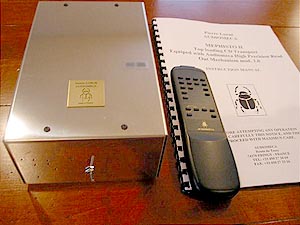 |
||||||||||||
If you haven't come across Audiomeca's Pierre Lurné before, I'll just mention that he is a bona fide legendary figure in the European pro audio community. He's a classically trained physicist specializing in rational mechanics who has pursued his love of audio with unusual rigor and persistence for several decades. His theory of the perfect tonearm (L'Audiophile, 1978) remains what is probably one of the most authoritative exposes on the subject, having led to several extremely desirable turntables and tonarms (the Romance and Romeo combination is still available today). In the mid-80s, Lurné turned his attention to the digital domain. After ten years of further study, he collaborated with René Boonen -- designer of the Philips CDM4 and CDM9 transports -- for serious research into the mechanics and vibrational impact inherent in transports. This led to the Audiomeca Model 1, a justly renowned transport used in his own top-line Mephisto II and licensed to a few select manufacturers building state-of-the-art players themselves. Lurné and Boonen are two of the most knowledgeable and innovative transport designers around, with the Audiomeca the only player designed from the ground up to exploit its full potential as intended. |
||||||||||||
| For those with a better understanding of the scientific arcana as they pertain to D-to-A conversion, here are some key features of the Mephisto II: The digital processor is 24-bit/192 kHz with 20- to 32-bit resolution, no phase-lock-loop beyond the input chip and completely independent in- and output clocks. The upgradeable DAC architecture was developed by Swiss engineering firm Anagram Technologies, undisputed world leaders in the field, who claim the digital 32-bit floating point DSP processing techniques involved result in virtually zero jitter. More readily quantifiable performance attributes are a S/N ratio of >107 dB, dynamic range of a mindboggling 140dB, and inter-channel separation of 125db. Connectivity includes standard gold-plated RCA and XLR analgue output connectors with Teflon insulation, two coaxial (1 standard, one direct) and one XLR digital output. |
||||||||||||
 |
||||||||||||
The unit measures 430mm x 365 x 160 and weighs 12 kilos. The elegant stainless steel power supply sports a single power toggle and a red light. Inside are separate modules for digital, analogue and input sections. While the choice of the computer cable umbilical is deliberate, it does limit experimentation with cables. I hope to look into further alternatives. Functionality is not Mark Levinson comprehensive. Features on the cheap plastic remote control (they're still working to a budget at £4500?) include just the usual suspects. Initialization is quite slow and a tad noisy until completed, seemingly in line with most top loaders I've come across. Track skip too does clock seconds for the lens to lock on. Programming allows storing of up to 20 selections. There's no random select, period. Repeat's for the whole CD but not individual tracks. The blue display won't dim, and though some people might find it small, it's easily legible at 10 feet and avoids the garish distractions of larger ones. The display command tracks through elapsed time and track numbers as well as scrolls through time remaining. The remote works very well off-axis to ease direct line-of-sight requirements, The front panel is sparse and simple. Four Perspex buttons control previous and next tracks, stop and play/pause. Leaving the lid open let's you observe how brutally warped most CDs are. It's amazing that the lens can follow the the plot line at all, given how the bits are held in grooves a daunting 1/50th the size of a human hair. |
||||||||||||
 |
||||||||||||
 |
||||||||||||
|
|
||||||||||||
| On with the music. Last night I played Trashmonk's Mona Lisa Overdrive. Trashmonk is what the hugely talented Nick Laird Clewes of the now-defunct Dream Academy hides behind. Nick's larger-than-life and my friend. The album represents the fruit of five years of layering track upon track, sample over sample, with Nick on most real instruments. A couple of tracks like "Sapphire" and "Inner Brownstone Symphony" are essentially voice/guitar duets. For most systems, the voice is the problem. Nick's almost whispering at times, with plenty of breathiness even as he vocalizes more strongly. Most system's fail at retrieving the inflections of the voice to miss a lot of what he's trying to communicate. |
 |
|||||||||||
|
He wrote "Inner Brownstone Symphony" while camping at a friend's New York house. The tune begins with a recorded train. Then voice and guitar emanate from the moving train with a haunting melody whose lyrics go:
|
||||||||||||
| " I'm watching all the leaves turn brown with nobody else around, they're just words that tumble down falling back onto the ground... A sad familiar melody started to unlock the key |
||||||||||||
 |
 |
|||||||||||
 |
||||||||||||